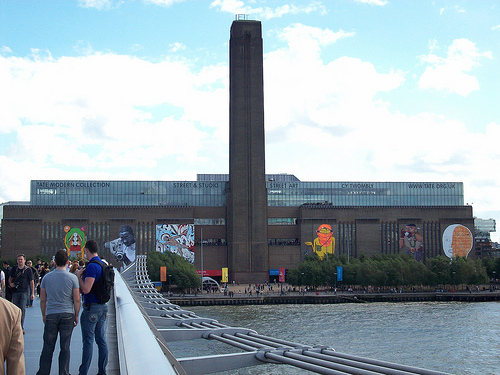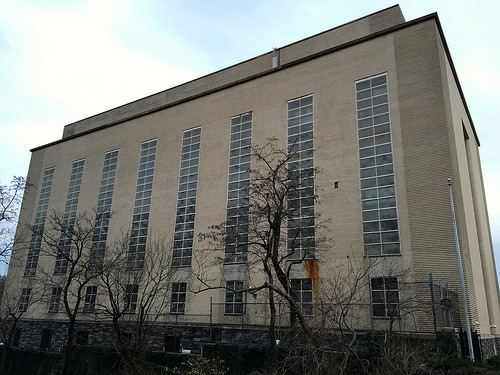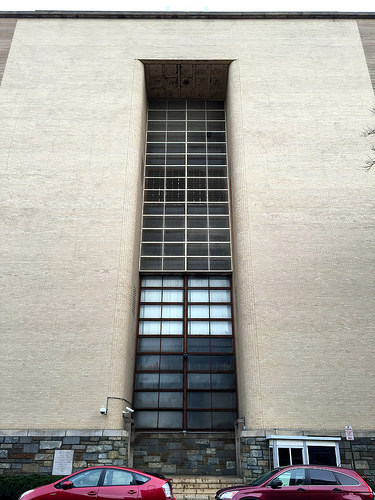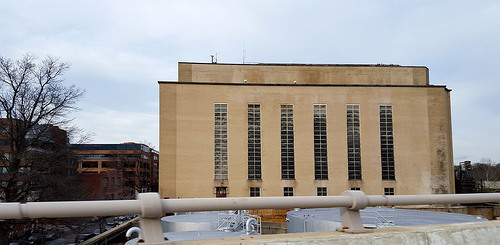An art deco industrial building in Georgetown could have a new use
Developers want to build a contemporary mid-rise residential tower on a prime site in Georgetown, but it’d mean tearing down a distinctive old heating plant. There might be ways to reuse the old building and build something new as well.
The West Heating Plant, which abuts Rock Creek Park on the edge of Georgetown, was built by the Federal government to provide steam heating for federal buildings in the District. Designed during World War II by architect William Dewey Foster, it opened in 1948 as one of the few examples of industrial art deco-to-moderne architecture in the District; the other is the Central Heating Plant on 13th Street SW.
The six-story structure now stands idle, having been decommissioned in 2003.
A team led by local developer Richard Levy purchased the plant from the Government Services Administration (GSA) in 2013 with plans to demolish part of the building for up to 80 luxury Four Seasons residences and use the former coal yard for a new park.
Unfortunately, preservation officials encouraged Levy’s team of notable architects - British architect David Adjaye and OLIN landscape architects - to be creative with the site without preserving the building. Levy understandably leapt at the opportunity.
In a presentation to the Citizens Association of Georgetown in December, Levy outlined plans to tear down the West Heating Plant entirely. His new plan includes a 60 to 70 luxury residences and the adjacent park.
The West Heating Plant is worth preserving
DC has few industrial buildings and even fewer that are architecturally significant. The West Heating Plant, despite its decaying state, is significant as both a notable industrial edifice and one of the few examples of moderne architecture in the city.
Eight massive vertical windows stretching nearly the building’s entire height dominate its north and south faces. A similar vertical portico dominates the 29th Street façade.
The West Heating Plant stands out on the Georgetown skyline as one approaches from the south or east, reminiscent of the neighborhood’s industrial past. Other remnants of this include the lofts in converted warehouses along the canal and the Capital Crescent Trail that was on the former Georgetown Branch railroad line.
The building is a worthy reminder of Georgetown’s history, and an impressive example of civic architecture.
Converting the plant to residences would be difficult
With or without Levy’s plan to demolish the West Heating Plant, it was never really feasible to convert the existing building into residences. Floors are only located on its 29th Street side, and shoring up the columns that run up and down the building would be costly due to years of corrosion.
In addition, at 109 feet wide, the building is deeper than is preferable to get good light throughout an apartment. The design team attempted to fix this in their earlier partial-demolition proposal by adding big shafts to the center of the structure to bring in light.
To fill the building with apartments or offices, the developers would also have to add a lot of windows. This would be problematic as the brick is only loosely attached to the steel frame. Adding windows would require painstaking care and, even then, might deface the monumental qualities that give the building interest.
In other words, it is a tough sell for a residential or commercial conversion even before he exorbitant cost of cleaning up the asbestos, PCBs, and other toxins scattered throughout the site.
Zoning and economics drove Levy’s demolition proposal
The original appeal for developers was that the West Heating Plant sits on just a fifth of the lot. When the GSA sold the facility, it anticipated the site would receive a waterfront zone district, W-2, allowing for 362,000 square feet of development up to 60 feet high, in its environmental assessment.
However, adaptively reusing the plant would offer only up to 143,600 square feet of space. While the building is tall, it only has six floors with high ceilings — 13 feet on most floors and 22 feet on the first — that allows for less density than the height suggests.
To address this disconnect, the GSA imagined that a developer would build a second flat and fat structure on the coal yard south of the heating plant that would peep over the Whitehurst Freeway viaduct. Since the conversion would ruin the dramatic interior spaces and significantly alter the monolithic exterior, it would have been a pretty hollow deal for developers and preservation interests alike.
Levy’s demolition plan is a compromise to the competing expectations of the developers and neighbors: there’s no second building and the new 10 stories of apartment fit into the existing massing. That’s more floors than with an adaptive reuse but less density and more open space than the GSA’s scenario. The height and the park secure the great views that high-end buyers will pay extra for and the park has quieted a lot of neighborhood concerns.
It is a clever solution but it is not the only one. There are options that preserve the historic plant and also get a distinctive new apartment building.
The West Heating Plant could be a new public space
If height is not really an issue, Levy could build a new 10-story building in the coal yard and reuse the actual plant for something much more creative.
There are ways to reuse the West Heating Plant that work in big messy spaces. Contemporary art institutions, like the Tate Modern in London, are a good example, especially if the first floor is open and free to the public, effectively making it an extension of the streetscape.

The Tate Modern gallery is located in the former Bankside Power Station in London. Image by Alquiler de Coches on Flickr.
The Tate Modern has been a staple of the London tourist circuit since its turbine hall hosted a series of blockbuster exhibitions shortly after it opened. This has prompted demands for contemporary art museums elsewhere with large spaces that can handle rough treatment, like the Dia:Beacon near New York City.
The West Heating Plant’s boiler room is an ideal candidate for such a space, something the Post recommended in 2012. While only about a third the size of the Tate’s 36,500 square foot turbine room, it is much bigger than the District’s last proposed contemporary art museum in the Franklin School. If two floors of the plant were cleared out, Adolf Cluss’s landmark school would fit comfortably in the boiler room.
The plant could also be used as a home for one of DC’s excellent theaters. A big box with three stories for flies could make the cornerstone of a spectacular alternative theater venue. The industrial patina, few windows and big spaces of the old plant again could be more of an asset than a drawback.
Realistically, to keep the old and add the new, any reuse of the site would have to assume a new building on the coal yard. This would likely mean more height and density on the site in order to allow development of as much of the 362,000 square feet allowed. It would also mean no new large park.
Dropping the park from the Levy’s proposal may not be a bad thing. The Georgetown Waterfront Park, just a few blocks from heating plant, was completed just five years ago and both Rock Creek Park and the C&O canal run along the site.
To offset the loss of the park, and curry neighborhood support for a higher and denser project, the boiler room of the new West Heating Plant art space could be part of a new public space with new entrances connecting it to both Rock Creek and the canal. Shops facing the canal could be added along the ground floor making it a popular neighborhood destination.
Compromises will undoubtedly be necessary to get the developer to support preserving the plant and the neighborhood to support more density on the site. But it would be well worth it.
A West Heating Plant site with both an extension of the urban fabric plus new public arts and green space at the intersection of two of DC’s most popular parks might be a altogether a better deal for Georgetown and the District.






